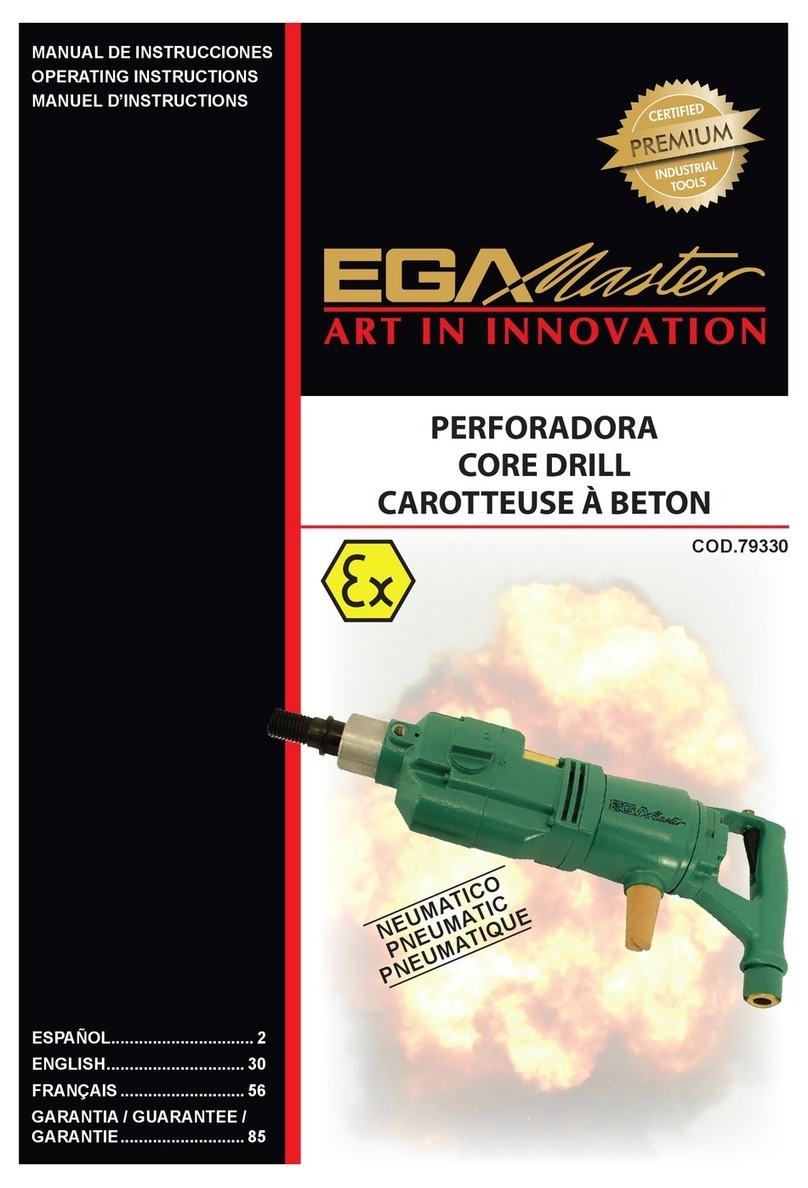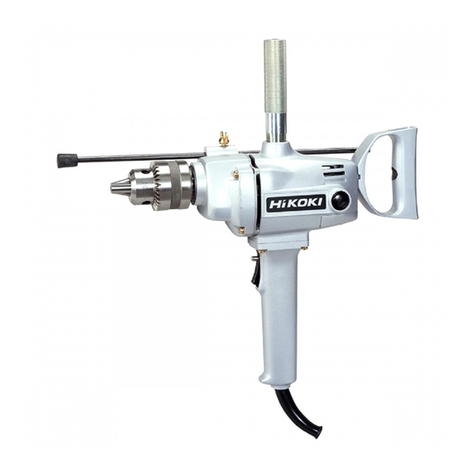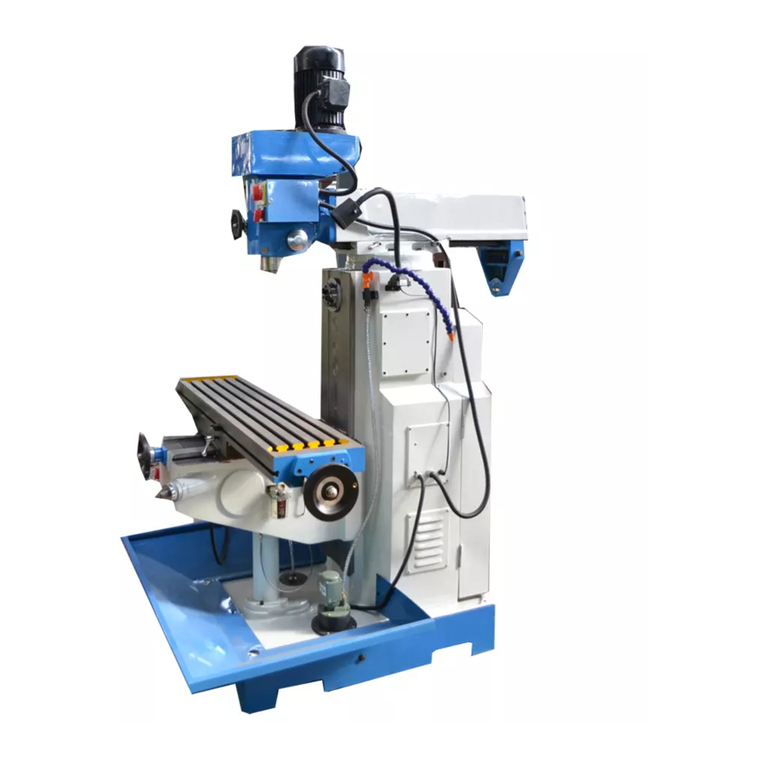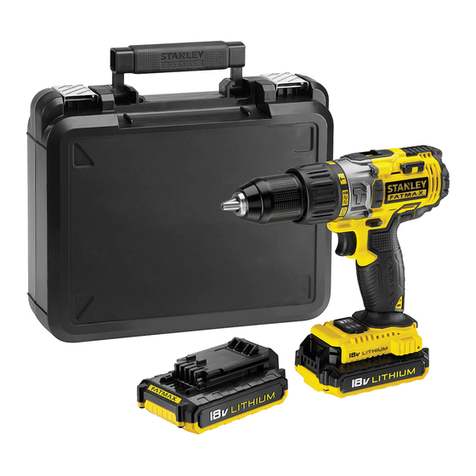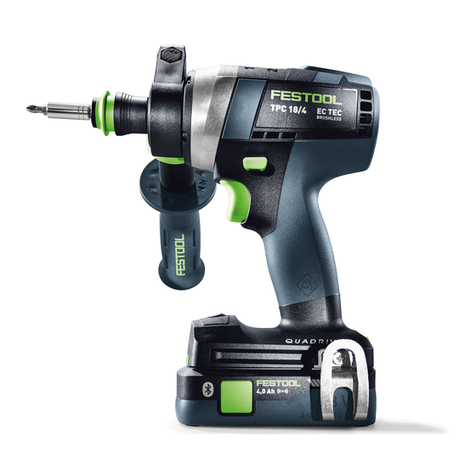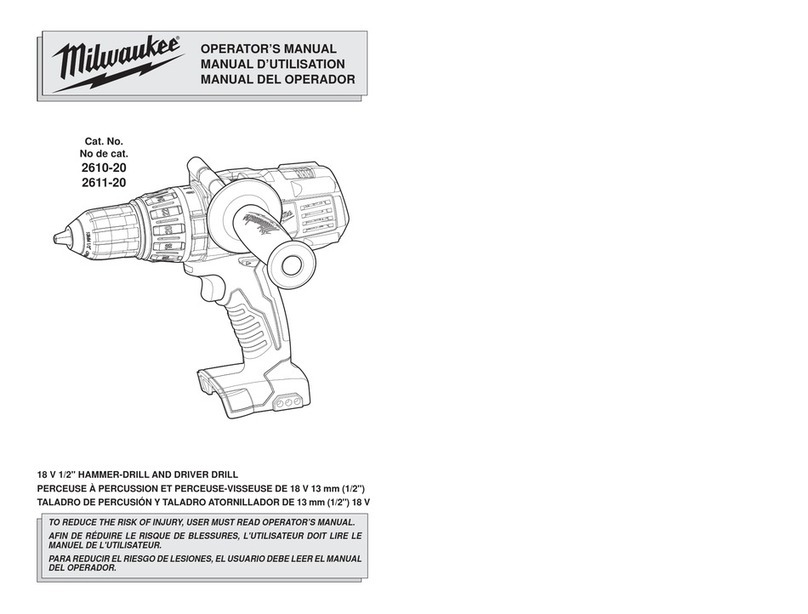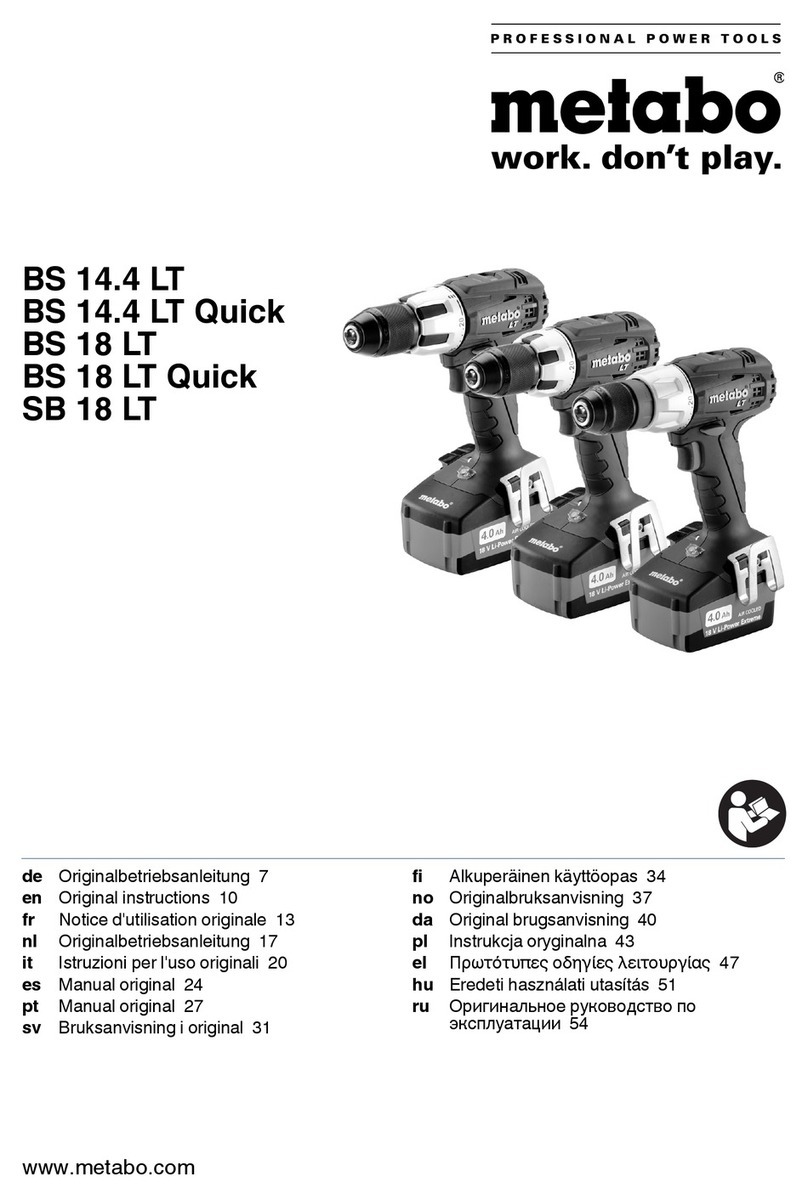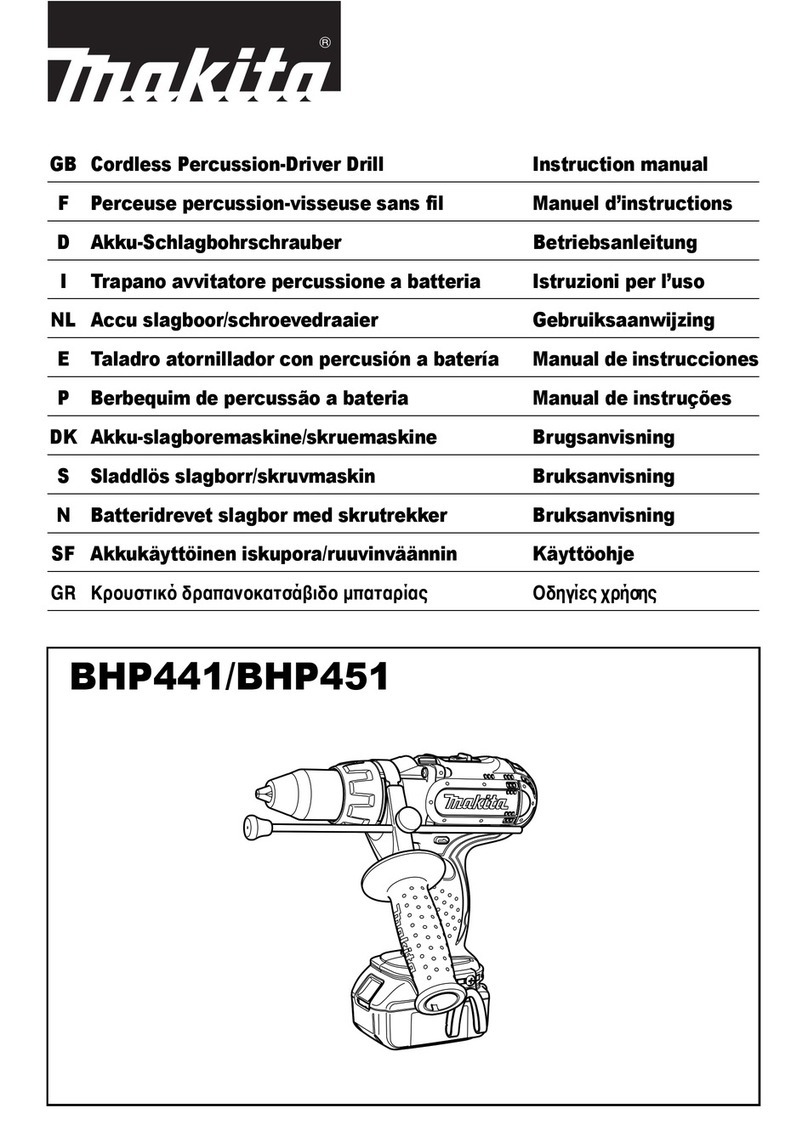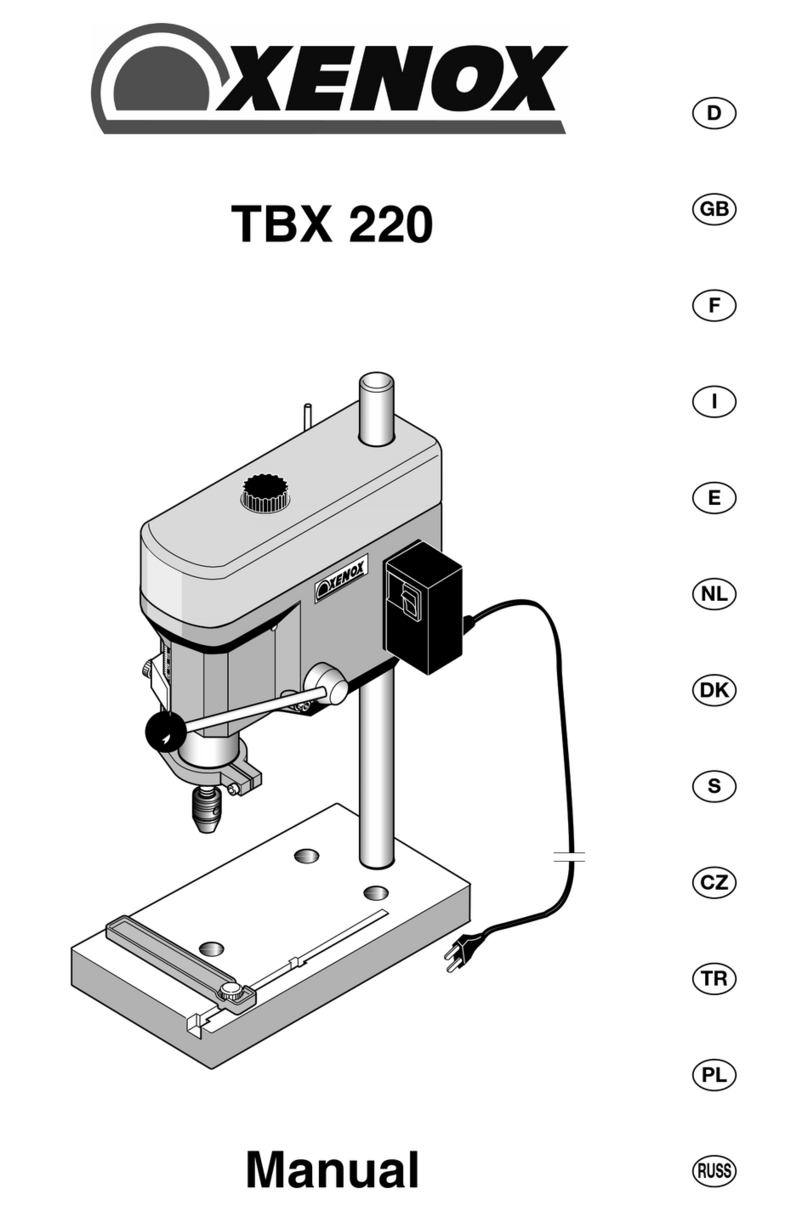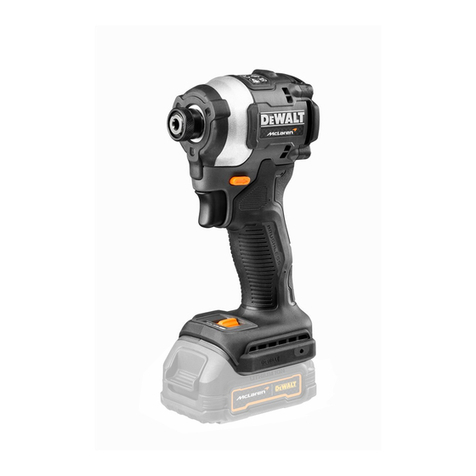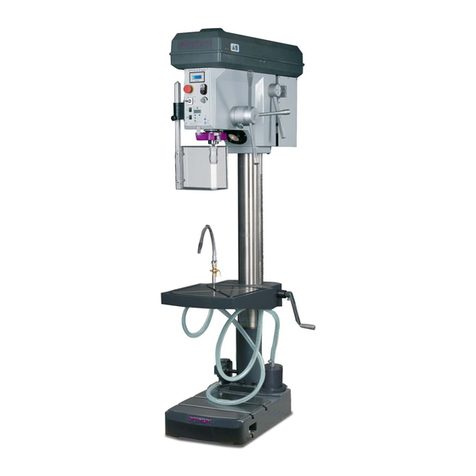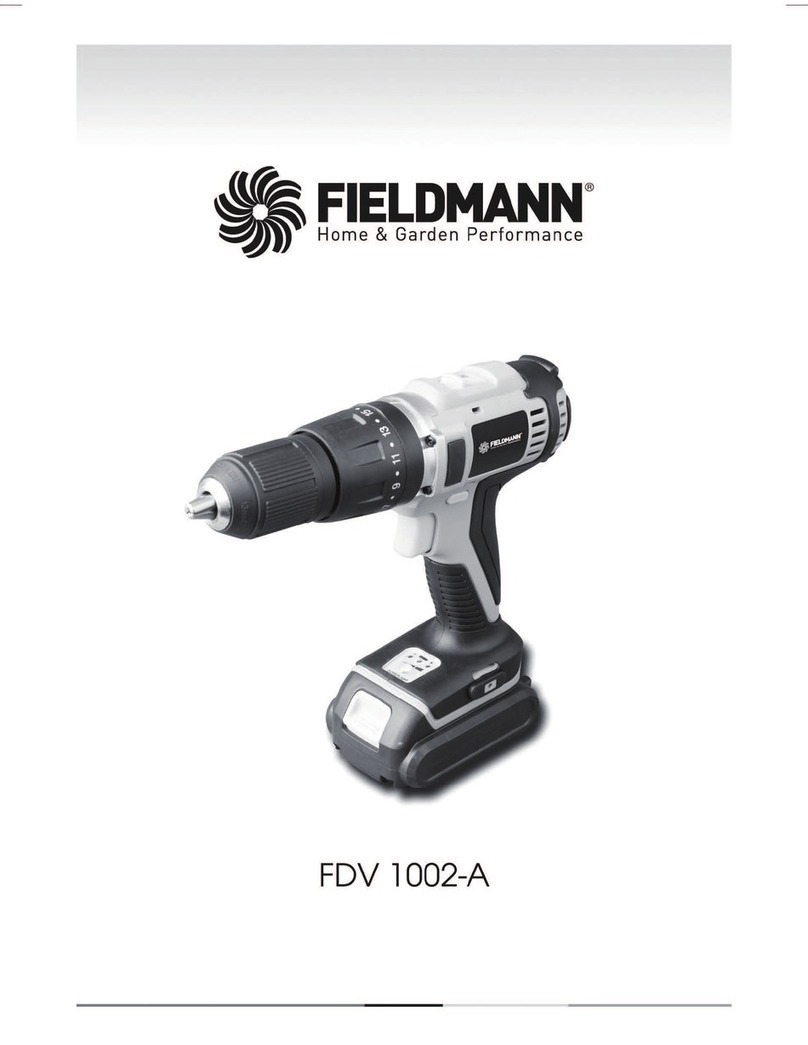EGAmaster 79605 User manual

OPERATING INSTRUCTIONS
D-HANDLE DRILL
ENGLISH................................ 2
GUARANTEE........................ 21
COD.79605

2
DIRECTORY
Signal Word and Symbol Denition ................................................................................. 3
Technical Specication ..................................................................................................... 4
Use ......................................................................................................... 5
Product Description ......................................................................................................... 5
Identication ........................................................................................................ 6
Installation ........................................................................................................ 6
Startup ........................................................................................................ 7
Basic Safety Instructions .................................................................................................... 8
Owner Obligations ........................................................................................................ 8
Operator Obligations........................................................................................................ 9
Symbol Denition for Safety Equipment and Accident Prevention .................................... 9
Safety Instructions for avoiding Safety Hazards ............................................................ 9-15
Disassembly- Re-assembly .............................................................................................. 16
Maintenance Instruction .................................................................................................. 16
Storage ...................................................................................................... 17
Disposal ...................................................................................................... 18
Environmental Regulations ............................................................................................. 18
Troubleshooting ....................................................................................................... 18
Warranty and Liability .................................................................................................... 19
Scope of delivery ...................................................................................................... 19
ENGLISH

3
SIGNAL WORD AND SYMBOL DEFINITION
The signal words and symbols used in the technical documentation (safety instructions,
operating booklet,
etc.) have the following meaning:
This symbol has the following meaning:
DANGER
Indicates an immediate danger, which causes serious injuries to any person or even death, if
not avoided.
WARNING
Indicates a threatening danger, which can cause serious injuries to any person or even
death, if not avoided.
CAUTION
Indicates a danger or unsafe procedure which can cause injuries to any person or material
damages, if not avoided.
NOTICE
Indicates a potentially dangerous situation which can cause damage to the product or its
surroundings, if not avoided.
WARNING – explosive atmosphere
Air and ammable substances can mix and result in an explosive atmosphere. In areas
exposed to explosion hazards, supplementary instructions and directives apply. Observe the
safety instructions of the owner as well.
WARNING – explosive material
Caution should be exercised when working with explosive material or in its surrounding area.
PROHIBITION – No naked ame, re, or ignition source and no smoking
Prevent from re and explosion hazards, which can be caused by naked ame, open ignition
source or by smoking.

4
Eating and drinking forbidden – The prohibition sign forbids the consumption of food.
REQUIREMENT – Observe the instruction
Ensure that the operation process is adhered to and avoid accidents and expensive down
times due to improper use of machines, devices and tools.
By using the mandatory sign you refer to the adherence of operation instructions.
This symbol has the following meaning:
NOTICE – Gives recommendations and important hints for handling the product
IMPORTANT – Indicates application advice and other particularly useful information.
REMARK:
In each case the symbol used does not replace the safety text. The text must always be read fully. In
some cases other symbols will be used with the signal words.
TECHNICAL SPECIFICATION
Operating/Flow pressure 6
Motor power 0.65
Speed under load 650
Drill chuck Quick-release
chuck dia. 13
Drilling capacity in steel max. 13
Air connection R 3/8“
ID of hose 13
Air consumption 0.68
Weight 5.7
Length with drill chuck 314
Noise pressure level LpA
(1) 89
Noise power level LWA 100
Vibration(2) <2.5
ATEX Classication - I M2 c T6

5
(1)Remark: Measurement acc. to DIN EN ISO
15744
Measurement uncertainty K: 3 dB (A)
Measurement uncertainty K: 1.5 m/s2
The performance data are guide values only, they depend basically on the application, the
operating pressure and the applied accessories.
USE
Intended Use
The manufacturer machines are designed for commercial/industrial use only. Only trained,
skilled personnel are allowed to operate the machine.
The drill serves for drilling of different work pieces and materials. The machine must be held
tight against rotation.
Improper Use
Any use deviating from the intended use as described is considered to be improper use.
Working without personal protection equipment. Using the machine in a kind of area exposed
to explosion hazards, which is prohibited for the machine. Drilling self-ammable material.
PRODUCT DESCRIPTION
1 Valve trigger
2 Motor housing
3 Air connection
4 D-Handle
5 Neck
6 Drill chuck
7 Second Handle
Functional principle
A drilling machine converts the pneumatic energy into mechanical work. In other words, the
compressed air drives the motor, which transmits the energy to the gear. At the same time the drill
chuck and the drill clamped in it are rotating.

6
IDENTIFICATION
Type sign Explanation of ATEX Identication
INSTALLATION
Requirements to the air supply
The pneumatic drill is designed for an operation pressure of 6 (4) bar. Pay attention that
the operation pressure is not lower. For maximum performance, the values given in the table
“Technical Specication“ have to be met.
The distance to the machine should not be bigger than 5 m.
The supplied compressed air has to be free from foreign objects and humidity, in order to protect
the pneumatic drill against damage, dirt and rust formation.
Remark: For the lubrication we recommend installing an oiler or a maintenance unit upstream
the machine. This ensures a proper functioning of the pneumatic drill. Always use acid and resin-
free oil (SAE 5W - SAE 10W).
Oils of high viscosity cause vane sticking and impair the start and performance of the machine.
Optimal lubrication will multiply the service life time. In winter, or if the compressed air is very
moist, an antifreeze lubricant, e.g. “BP-Energol AX 10”, “Kilfrost” or “Kompranol N 74” should be
used.
Pay attention that the diameters of all lines are big enough and there are no restrictions. There
must be no buckles in the hoses.
Check the supplied ow pressure. The ow pressure has to be adjusted with the pressure control
valve (see technical specications).
Supply hoses have to be designed for a minimum operating pressure of 6 bar.
Replace hose lines regularly at preventative maintenance, even if there are no damages (observe
the instructions of the manufacturer).
Always use hoses, which have an oil resistant inner surface and an abrasion-resistant outer
surface. If you are next to electric conductors, always use hoses which are proved and specied to
be non-conductive.
For use in areas exposed to explosion hazards always use hoses and lubricating oil, which meet

7
the safety requirements of the owner.
Connecting the air supply to the pneumatic drill
Remove the locking cap from the connection 3 (see g. 2) at the air inlet.
Screw a pneumatic hose (not contained in the scope of delivery), into the connection 3 at the air
inlet.
Fig. 2
STARTUP
Mounting the drilling tool
Ensure the machine is not connected to the air supply, when mounting the drilling tool.
Open the drill chuck 6 by turning, until the drilling tool can be mounted. Insert the drilling tool.
Put the drill chuck key (see g. 3) into the corresponding drillings of the drill chuck 6 and tighten
the drilling.
The optimum output of the pneumatic drill is at an operation pressure of 6 bar, measured at the
air inlet of the running pneumatic drill. When connecting the machine, ensure that the valve trigger
1 (see g. 4) is not actuated.
Before connecting, blow out the hose. Never connect a pressurized pneumatic hose (see safety
instructions for prevention of hazards caused by compressed air). First connect the machine and
then the air supply.
Replacing the drilling tool
Disconnect the pneumatic hose. Wear protective gloves when replacing the drilling tool.
The drill and the drill chuck can heat up during longer operation. Open the drill chuck 6 by
turning, until the tool can be taken out.

8
Prior to starting work Check
• the oil level. If necessary, rell oiler (line oiler or maintenance unit)
• if the drilling tool is rmly clamped to the drill chuck.
• if the pneumatic hose is correctly connected.
Start the machine by actuating the valve trigger 1 and start operation. (The speed can be adjusted
by opening the valve more or less, or by increasing, respectively lowering, the drill pressure.)
After nishing the work
• Shut the valve
• Shut compressed air supply and disconnect air hose.
• Dismount drilling tool, if necessary
• Check oiler
BASIC SAFETY INSTRUCTIONS
Read operation instructions/safety instructions!
Before working on or with the tool, read the safety instructions and follow the instructions during
operation.
Do not modify machine or machine tools and accessories after receipt. Permission from the
manufacturer must be obtained before any modications or alterations are done in compliance with
all safety instructions. Use the machine only for its intended use. Observe the technical data of the
equipment and the ambient temperatures. Pay attention to labels, restrictions of use and special
instruction notes on the machine tools and the machine itself. Regularly check that the type plate
and symbols on the machine are legible. If necessary, contact the manufacturer to replace them.
Only operators with technical knowledge, trained by authorized responsible technical personnel,
may install, adjust, operate, transport and store the machine.
OWNER OBLIGATIONS
Generally, the machine owner is responsible for correct condition/operation of the machine and
adherence to the safety regulations. The state-of-the-art machine is built according to recognized
technical safety regulations. However there is still a risk of accidents to the operator or third parties
or damage to the machine or other objects, when using it. All current regulations and specications
which apply to the site of operation in regards to accident prevention, installation of electrical and
mechanical systems as well as radio interference must be observed.
IMPORTANT - The owner must make sure that...
• Risk assessment is carried out for the specic risks, which can occur due to any operation of
the machine.

9
• the function of the safety equipment is regularly checked.
• the safety symbols and safety notes on the machine/ device and the operating instruction
booklet are observed.
• the safety instructions and the operating instruction booklet are available completely and in
legible condition on site with the machine.
The owner is obliged to only allow personnel to work on the machine who,:
• are familiar with the basic work environment safety rules and accident preventing
regulations. Also, those persons must have been instructed in the correct use of the machine.
• have read and understood the safety and warning notes in the operating instruction booklet
as well as all other documentation pertaining to the machine.
• have been tested at regular intervals in regards to their safety-conscious operation of the
machine.
Safety-conscious working
Additional to the safety instructions in this manual and the intended use, the following safety
regulations have to be observed:
• Accident prevention instructions, safety and operation regulations
• Explosion protection directives
• Safety regulations for the operation with hazardous material
• Norms and laws being effective
OPERATOR OBLIGATIONS
All persons who are assigned to work with the machine are obligated to:
• always pay attention to the basic safety and accident preventing regulations.
• always read and follow the safety and warning notes in the operating instruction booklet.
SYMBOL DEFINITION FOR SAFETY EQUIPMENT AND ACCIDENT PREVENTION
Use protective clothes – Protective clothes are necessary for diverse applications, e.g.
protection against chemicals, heat and cold. Provide appropriate protective clothes to your staff and
identify this requirement by convincing signage.
Use eye protection – whether goggles, laser safety goggles or etc. –
identify areas where eye protection has to be used, by appropriate mandatory signs.
Use ear protection – Capsule hearing protectors or hearing protectors have to be used
for ear protection, depending on the sound intensity at the work place.

10
Provide appropriate ear protection and identify the obligation for using ear protection by
appropriate mandatory signs.
Use foot protection – Foot injuries by vehicles, objects, hot material or hazardous
substances can be avoided by appropriate protective shoes. Equip your staff with appropriate
protective shoes and identify those requirements properly.
Use hand protection – Identify convincingly the safety requirement “Use hand
protection“ by a gloves sign, respectively a gloves symbol.
Use respiratory protection – Ensure that the specied protection equipment is
available and that it is used. Identify by mandatory signs, where and when respiratory masks are
required.
Danger Zones:
Operational
condition
-----------------
Life phase
Normal function Malfunction Improper use Expected use
Transport
Transport of
the machine in
an inoperable
condition
Drop of the
machine
Transport of the
machine in an
operable condition
unknown
Startup
Equipment of the
machine with
designated tools
unknown
Equipment of the
machine with
grinding pins or
other tools
unknown
Operation
Machine only
works with
actuated valve
Machine runs
without intended
actuation
Valve is blocked in
actuated condition; unknown
Machine moves the
tool Tool blocks unknown unknown
Maintenance
Regular cleaning Breakdown of the
machine unknown unknown
Operation at a lter
unit
Breakdown of the
machine unknown unknown

11
SAFETY INSTRUCTIONS FOR PREVENTION OF WORKPLACE HAZARDS
WARNING – The following applies unless otherwise stated in the machine’s operating
instructions booklet: The machine is not insulated to protect against an electrical power surge.
CAUTION – risk of injury!
Hands may be crushed, seized or otherwise injured.
Keep your hands away from areas which are marked with this symbol.
CAUTION – risk of injury!
Remove all sources of danger which could lead to slipping, tripping or falling (e.g. slippery
surface, hoses, cables).
Keep the work area clean and dry.
PROHIBITION – Eating, drinking and smoking are forbidden during
operation.
WARNING – Explosion hazard!
Operate the machine according to the intended use only.
The machine is designed for the use in areas exposed to explosion hazards as well.
The generation of heat and –eventually- sparks at the drilling point is characteristic for drilling.
The drilling point has to be rinsed, respectively cooled, continuously with water, where high
temperatures or eventually ying sparks are to expected. Observe the following:
• Valid local explosion protection directives.
• Technical specication of the machine.
• Markings on the machine.
• Avoid the generation of sparks.
• When operating the machine, do not push or beat against other material and hold the
machine rmly and safely by hand.
• Do not slide the machine over the ground.
• If heat generation exceeds the specied surface temperature, the machine has to be stopped
instantly. It only may be re-started after having eliminated the cause for the fault.
• The work area and the next working areas should always be protected from sparks.

12
• Flammable and explosible material has to be removed from the work area before
work is started. Among others, this relates to dust deposits, cardboard, packing material, textile,
wood and wooden splints, but also ammable uids and gas.
Ensure adequate lighting.
Be extra careful in unfamiliar surroundings. There is a risk of hidden hazards such as electric
lines or other supply lines. Make sure when operating the machine that no electrical cables, gas
pipes or similar could be damaged. Use suitable and personal protective equipment.
SAFETY INSTRUCTIONS FOR PREVENTION OF HAZARDS CAUSED BY COMPRESSED AIR
WARNING – Compressed air can cause severe injury. Before working on the tools
(e.g.)
installation, changing accessories or machine tools, prior to a long standstill, maintenance, etc.)
depressurize pneumatic equipment (close valve and depressurize pneumatic hose).
CAUTION – Risk of injury by whipping pneumatic hose.
Check pneumatic hoses, connection components and ttings regularly for any damages and
proper xture.
When connecting / disconnecting the machine to / from the pneumatic supply, please pay
careful attention not to actuate the start lever while doing so. Never remove a pressurized
pneumatic hose. Always switch the power supply off rst and then depressurize the machine
by pressing the valve latch. The maximum operating pressure (ow pressure) according to the
technical specication must not be exceeded. A pressure regulator should be installed, which
regulates the pressure before it reaches the machine. Never direct a pneumatic hose at yourself or
anyone else. Never clean your clothes with compressed air. Direct cold air away from your hands.
Do not pull or carry the machine by the pneumatic hose. When using claw couplings make sure
that they are tted with a suitable lock mechanism (e. g. lock pin) and a safety chain.
SAFETY INSTRUCTIONS FOR PREVENTION OF OPERATING HAZARDS
Before beginning work make sure that the hands are protected from the following hazards whilst
working with the machine: impacts, crushing, hits, cuts, abrasions and heat.
The operating and maintenance personnel must be physically able to handle the bulk, weight,
power and/or torque of the machine. Do not use the machine if you have taken any medication
or drugs, after drinking alcohol or with any other constraints on your vision, reaction time or
judgment. Work in the best possible position so that you can react with both hands to any normal
or unexpected movements of the machine. Maintain a balanced body position and secure footing
in order to avoid improper strain and to be able to support the reaction torque of the machine. If
you cannot safely support the reaction torque of the machine, then use a torque support (e.g. linear
stand, telescopic arm, holding xture/ holder-on, support grip). Additionally observe the following:

13
• Only operate the machine after having carefully read the operation manual.
• Only use drilling tools appropriate for the application with this machine.
• The work place has to be secured according to the instructions, in order to avoid injury to
persons nearby due to projectiles coming-off. The machine is for hand-held operation only. All
other parts of the body and extremities have to be kept in reasonable distance.
• Read carefully the manufacturer’s instructions and ensure that the drilling tool is appropriate
for the application and that it has the correct dimensions.
• Restrictions for use and other instructions by the manufacturer, which are contained in the
documents supplied.
• Check the secure xing of drill chuck and drilling tool before starting work.
• Remove the wrench 7 (if available) before starting the machine (see g. 3).
• If the machine blocks, higher reaction torques can occur. Blocking can be caused by:
overload, tilting of the drill in the work piece or when penetrating the material to be drilled. Do
not let the drill rumble on the work piece, as this will most likely increase the vibration. Reduce
the contact pressure shortly before the drilling tool drills through the material (for thin walled work
pieces there is the risk that the drill hitches the work piece and lifts it.) It is possible that the drilling
tool keeps on running after the machine has been switched off. Deposit hand-held machines in a
secure position and wait until it stops, without applying any pressure to the surface.
• Never stop the drill chuck or the drill by hand.
SAFETY INSTRUCTIONS FOR PREVENTION OF ENTANGLEMENT HAZARDS
CAUTION – Loose clothing, personal jewellery (e.g. necklace), scarves/ ties, long hair
or gloves can get caught up in the machine tool or accessories and thus cause severe injuries (lack of
breath by throttling, abrasions, skin injuries and/ or cuts and lacerations).
Wear suitable, close tting work clothing!
Wear a hair net, if you have long hair.
When handling the machine, jewellery, necklaces, etc. have to be removed or are forbidden,
respectively.
SAFETY INSTRUCTIONS FOR PREVENTION OF NOISE HAZARDS
Always wear hearing protection (EN 352) – This refers to the operator, as well as to
any other person within the vicinity of the machine. Observe the instructions of the employer and of
the professional association.
High noise levels during operation can cause permanent hearing problems such as tinnitus
(ringing, buzzing, whistling or humming in the ears), hardness of hearing or even deafness.
• Before starting work, ensure that the provided, respectively the factory-made, sound absorbers
are mounted and in proper condition.
• If possible, use sound absorbing material, in order to avoid ringing noise at the work pieces.

14
SAFETY INSTRUCTIONS FOR PREVENTION OF VIBRATION HAZARDS
Vibrations can cause disabling damage to the nerves and blood supply of the hands and arms.
• Wear warm clothing and keep your hands warm and dry when working in cold conditions.
Exercise hands and ngers regularly.
• Do not hold the machine tool with the free hand.
• Use stands and/or weight balancers, if possible.
• When using a support (e.g. stand) make sure the machine is securely xed. If no support is
used, hold the machine with light but safe grip in order to support the tool’s reaction torque. The
tighter the grip the greater the risk from vibrations.
• Mount the machine as described in the operating instruction booklet in order to avoid
unnecessary high vibrations.
• Stop work immediately, if you feel any numbness, tingling, pain or whitening of ngers or
hands. Inform the employer and consult a doctor.
SAFETY INSTRUCTIONS FOR PREVENTION OF DUST AND FUME HAZARDS
Wear respiratory protection - Use respiratory protection as instructed by your employer
and as required by occupational health and safety regulations. Potentially generated or disturbed dust
and fumes in the working environment or from using the machine can cause ill health (e.g. cancer,
birth defects, asthma and/ or dermatitis).
• Carry out risk assessment regarding dust and fume hazards and implement appropriate
measures.
• Keep the working place clean.
• Keep in mind that working in certain materials may create dust and fumes causing a
potentially explosive atmosphere.
Remark: Some types of metal may have toxic coatings.
Please pay particular attention to avoid skin contact and breathing in, when working with those
materials. Always use a protective mask. Ask your material supplier about special safety instructions
and stick to them.
SAFETY INSTRUCTIONS FOR PREVENTION OF PROJECTILE HAZARDS
Wear impact-resistant safety goggles (EN 166) – This refers to the operator, as well
as for the persons within the vicinity of the machine. Assess and determine the grade of protection
required depending on the individual case. The risks to others should also be assessed at this time.
On overhead work, wear a safety helmet (EN 397). If a work piece, accessories,
inserted tools, or the tool itself breaks, there is danger from high velocity projectiles.

15
• Before using the machine check all parts for damages.
• Replace damaged parts immediately.
• When working on brittle material make sure that you are protected against harmful splinters.
SAFETY INSTRUCTIONS FOR PREVENTION OF ACCESSORY HAZARDS
Only use machine tools, accessories and consumables, which are recommended by the
manufacturer. Make sure choosing the correct size and the correct type. Only use accessories, which
are in proper condition and do not touch them during operation.
WARNING – Injury due to carelessness!
ATTENTION – If the machine is xed to suspension equipment make sure that it is
secure. Never hang the machine onto the supply line.
• Separate the machine form any external energy source before changing the machine tool or an
accessory.
• Avoid direct contact with the machine tool during and after use as it can be hot or sharp.
Wear protective gloves!
Defective/ inappropriate gloves can lead to injury. Only wear proper hand protection, adapted to
the work place requirements.
WARNING – Explosion hazard!
When operating the pneumatic drill in areas exposed to explosion hazards, only use accessories,
respectively devices, which are ATEX approved and specied. Use low-sparking accessories.
SAFETY INSTRUCTIONS FOR PREVENTION OF TRANSPORT HAZARDS
CAUTION – Improper Transport, danger of life due to parts falling down! Damage of
the machine!
• Never carry the machine at the supply line.
ATTENTION – Separate the machine from any external energy source before
transportation.
Check that the machine is undamaged and in proper condition. Wear worker’s protective
shoes!

16
DISASSEMBLY- RE-ASSEMBLY
Maintenance and Upkeep
Basic Safety Instructions:
WARNING – Maintenance and repair work on pneumatic equipment.
Compressed air can cause severe injury. Observe legal regulations. Take precautions for persons
and environment.
Additionally, observe the following:
• Secure machine against unintentional starting and let the machine cool down to the ambient
temperature
• Use suitable transport equipment, hoists or lifting accessories for moving heavy assembly
groups or parts. Protection against tipping, tumbling or falling down when assembling/ disassembling
the machine/parts.
CAUTION – Skin exposure to hazardous dusts may cause severe dermatitis. Dust present at the
work place could be disturbed during the maintenance procedure and inhaled. Clean machine and
work place before maintenance work.
WARNING – Danger of explosion! Generation of sparks during maintenance work!
Observe local safety regulations. Avoid use of force when disassembling and assembling the
machine. Always do maintenance work outside areas which are not exposed to explosion hazards.
PROHIBITION - Eating, drinking and smoking are forbidden during
maintenance and repair work.
NOTICE – Only use original the manufacturer tools, in order to avoid damages.
Check the adherence to the technical specications according to the operation manual after each
maintenance work. Only use genuine spare parts. Otherwise you risk a decrease in machine
performance and an increase in maintenance work.
IMPORTANT – There is no warranty for damages and liability is disclaimed, if non-original spare
parts are used.
MAINTENANCE INSTRUCTION
Generally, pneumatic machines need little maintenance. If the following rules are observed, the
machine will have the expected long life-time and high reliability. Service life and performance of the
machines are decisively determined by:
• The air purity
• The lubrication conditions and maintenance

17
The regular control of the compressed air lter, as well as the regular checking of the machine
with regards to external damages.
Inspection and maintenance can be done by the operator. Disassembly and re-assembly of the
machine have to be executed by qualied staff only. Incorrect assembly can lead to danger of
accident for the operator and to defects on the machine.
After completing maintenance and repair work and before restarting production make sure that...
• All materials, tools and other equipment which are required for maintenance or repairs have
been removed from the work area of the machine.
• Any uid leaks have been removed.
• All safety devices on the machine have proper function.
• The oil level was checked, if necessary.
• Fixtures of screw connections are tight.
• Removed container covers, screens or lters were reinstalled
The owner ensures that all maintenance, inspection and assembly work is done by authorized and
qualied experts, who have been appropriately informed by thorough study of the operation manual.
Disassembly- Re-assembly
Maintenance and repair
Disassembly and re-assembly should be done according to the exploded views, respectively the
sectional drawings (see repair instruction). All work regarding disassembly and re-assembly, as well as
maintenance and repair have to be executed by the manufacturer or skilled staff only.
DANGER – Working with the machine without appropriate preparation and
disregarding of instructions. Shut down the machine properly and let it cool down to the ambient
temperature.
NOTICE – Special instructions apply for the repair of explosion-proof machines.
Retrots or modications of the machine can affect the explosion protection. Therefore, retrots or
modications are allowed upon agreement with the manufacturer only.
The explosion-proof machine is designed in the type of protection “c“ constructive safety. All
work executed on the machine, inuencing the explosion protection, e. g. repairs with mechanical
machining, require an approval of an authorized expert or have to be done by the manufacturer. The
internal structure must remain unmodied.
The manufacturer is available for all maintenance, repair and assembly work, as well as for
damages.
STORAGE
Unused machines and machine tools should be kept in a dry, closed room.
Keep them free from damaging inuences such as damp, frost or large temperature uctuations as
well as mechanical damage. Always store the machine in a way that important machine instructions,
e. g. on stickers and signs, are legible.

18
DISPOSAL
Dispose worn out/defective machine tools according the local/national regulations. Fully
disassemble machine for the necessary disposal. Separate materials according to local environmental
specications. Dispose environmentally hazardous greasing, cooling or cleaning agents in order to
avoid environmental contamination.
ENVIRONMENTAL REGULATIONS
When working on or with the equipment, it is imperative to observe all legal requirements in
regards to waste-disposal and proper recycling.
In particular during installation, repair and maintenance work, water damaging
agents, such as:
• lubricating grease and oil,
• hydraulic uid,
• coolant,
• solvent containing cleaning agents
must not leak into the ground or reach the sewage system.
These materials must be stored, transported, contained and disposed of in suitable containers!
TROUBLESHOOTING
Problem Cause Remedy
Machine doesn’t start
Not connected to compressed
air
Rotor rusty due to humidity
Vanes jam (worn out)
Gear blocks
Connect and open the supply
line
Disassemble motor and
clean Check functioning of
maintenance unit
Disassemble motor and clean,
replace worn out parts
Disassemble gear, clean,
replace worn out parts
Valve trigger jams Impurities in the valve Clean valve seat
Machine is rotating too slowly
Operating pressure is too low
Rotor is rubbing against the
end plate / cylinder bushing
Gear parts are worn down
Increase the operating pressure
on the machine to 6 bar
Dismantle and clean the motor;
replace worn parts and align
the motor again
Dismantle and clean the
gearing; replace worn or
damaged parts

19
Problem Cause Remedy
Motor seizes up / jammed
Vanes are worn or broken;
broken parts are jammed
between the rotor and the
cylinder bushing
No lubrication – ball bearings
were running dry; rotor was
rubbing against the end plates
Coarse dirt particles in the
motor compartment between
the rotor and the cylinder
bushing
Dismantle and clean the motor;
replace worn parts and align
the motor again
Dismantle and clean the
gearing; replace worn or
damaged parts
Dismantle and clean the motor;
replace worn parts and align
the motor again
Gear makes loud noises
Needle cages are defective
Gear teeth are chattering Ball
bearings are defective
Dismantle and clean the
gearing; replace worn or
damaged parts
Drill cannot be clamped in the
drill chuck
Drill chuck defective
Diameter of drilling tool too
small
Replace drill chuck
Use tool with larger diameter
We ask you to send the machine to the manufacturet, if necessary.
WARRANTY AND LIABILITY
Unless otherwise specied, our “General Sales Terms” apply. Warranty and liability claims in
regards to persons or equipment damages are invalid, if one or several of the following causes
apply:
• Improper use of the machine.
• Improper assembly, startup, operation or maintenance of the machine.
• Operation of the machine with defect safety devices or improperly xed or non-functioning
safety and protection devices.
• Non-observance of the instructions in the operating instruction booklet concerning transport,
storage, assembly, startup, operation, maintenance and setting up of the machine.
• Independent structural alterations or settings on the machine beyond the intended purpose .
• Inadequate supervision of wear parts.
• Improperly carried out repairs, inspections or maintenance
• Catastrophic cases because of a war, acts of god or other reasons which are beyond our
control.
SCOPE OF DELIVERY
Check, if the scope of delivery is complete:
1 Operation and maintenance manual
1 Pneumatic Drill

20
Table of contents
Other EGAmaster Drill manuals

EGAmaster
EGAmaster 79422 User manual

EGAmaster
EGAmaster 79906 User manual
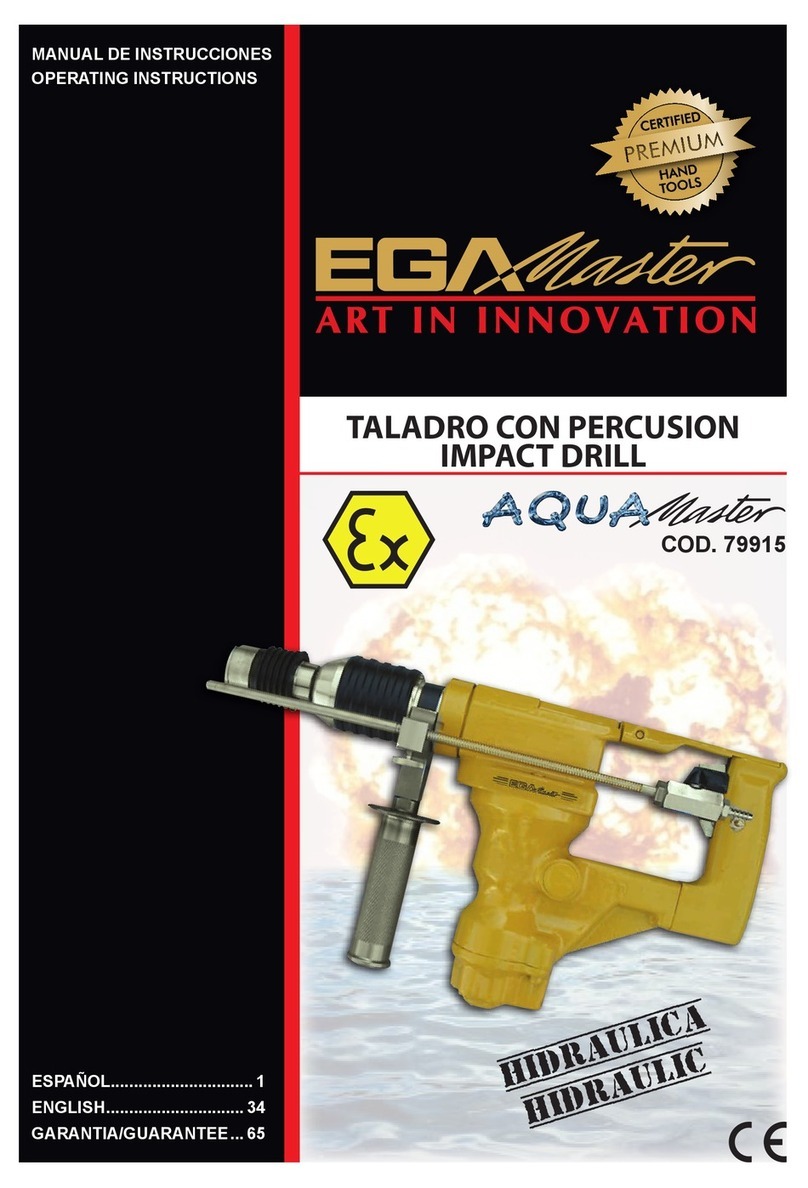
EGAmaster
EGAmaster AQUAMASTER 79915 User manual

EGAmaster
EGAmaster 79915 User manual

EGAmaster
EGAmaster 79632 User manual

EGAmaster
EGAmaster Aqua Master 79908 User manual

EGAmaster
EGAmaster 79904 User manual

EGAmaster
EGAmaster 79602 User manual

EGAmaster
EGAmaster MASTEREX 79303 User manual
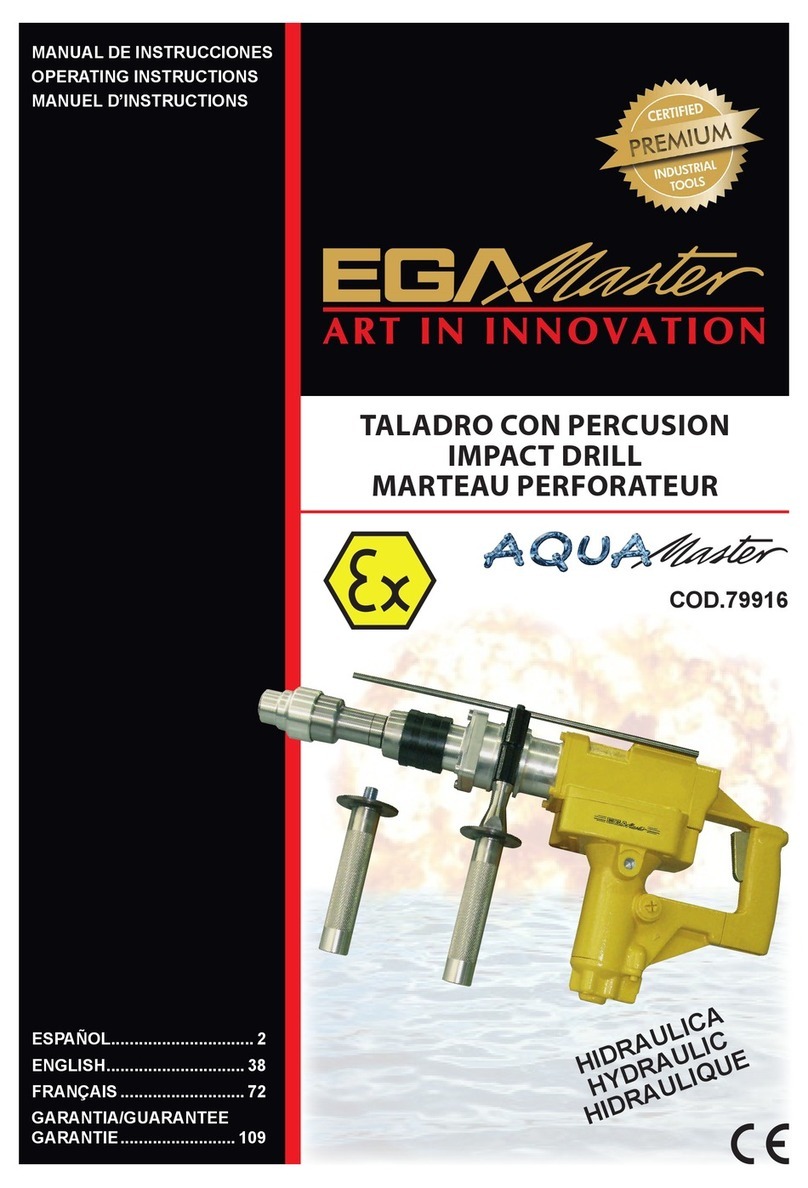
EGAmaster
EGAmaster AQUAMASTER 79916 User manual



